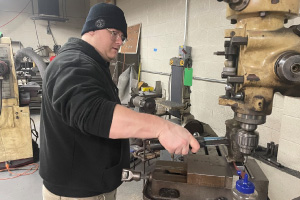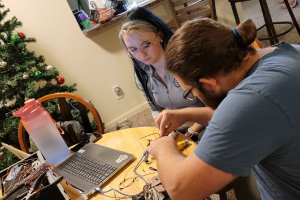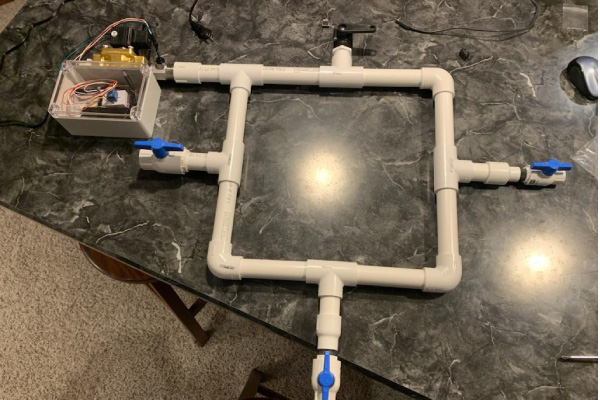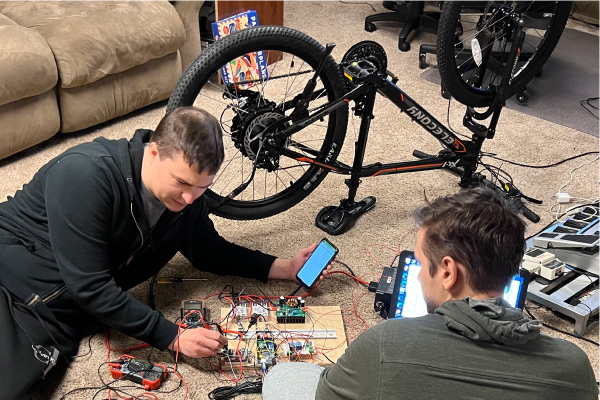ENT Senior Design Day 2022
Student teams conduct major open-ended research and design projects. Elements of the design process including establishment of objectives, synthesis, analysis, and evaluation are integral parts of the capstone. Real-world constraints such as economical and societal factors, marketability, ergonomics, safety, aesthetics, and ethics are also integral parts of the capstone. ENT 497: feasibility studies performed; ENT 498: implementation, testing, and production of design.

Through the Lens
On April 29, ENT seniors shared their research results and presented design projects to more than 40 ENT alumni and community partners.
Presentation Schedule and Project Descriptions:
ROOM A

9:30 a.m.
Hexapod Robot Analysis
Students: Jon Henderson and Mike Josefovsky
Advisors: Gary Drigel and Mert Bal
Student engineers purchased a hexapod robot kit that utilizes a Raspberry Pi for motion and AI control. Students performed both qualitative and quantitative testing to analyze several areas of robot performance and limitations. Students applied engineering concepts and statistical analysis as part of the project.
 10 a.m.
10 a.m.
Automatic Solar Tracker
Students: Mohamed Belkhair and John Pham
Advisors: Rob Speckert and Ayo Abatan
Student engineers designed, built, and tested a solar tracking system that will improve the energy yield compared to static solar panel systems. The solar tracker will automatically tilt and face the direction of the sun as it moves from east to west.
 10:30 a.m.
10:30 a.m.
Ultrasonic Tester *Fleck Fund
Students: Giancarlos Castro, Bill Ryan, and Mark Smith
Advisors: Gary Drigel and Zhiyuan Yu
Engineering students developed a laboratory module and operation guide to introduce Non-Destructive Testing (NDT) and the usage of ultrasonic scanning for part inspection and defect detection. The project outcome provides for the safe and basic operation of the Mistras UltraPAC UPK-T10 immersion ultrasonic testing equipment.

11 a.m.
Exo-Joint: Knee Extension and Stability Brace *Fleck Fund
Students: Bradford Pierce and Joni Rolle
Advisors: Rob Speckert and Ayo Abatan
Student engineers developed an Exo-Joint Knee brace for workers in the trades industry. This device will stabilize and protect the knee in various work environments. The system utilizes stored spring energy to assist the knee when extending from a crouched or bent position. This assistance will be integrated into a padded knee protection system.

11:30 a.m.
Portable Tensile Tester *Fleck Fund
Students: Owen Apted, Andrey Castel, and Josh Tongono
Advisors: Gary Drigel and Zhiyuan Yu
Project Tensile Tester aims to put an end to Pandemic raised questions of university engineering students being unable to receive proper hands-on learning of important strength of materials principles, such as Young’s modulus and the interpretation of Stress/Strain curves. ENT professors oversee the project which encompasses the use of an easily accessible, fully functional, portable tensile tester, paired with lab procedures written by Miami University senior engineering students.
 1:30 p.m.
1:30 p.m.
Benchtop CNC Mill
Students: William Allen, Shane Dunlap, and Gary Beebe
Advisor: Gary Drigel
Student engineers designed and built a Benchtop CNC Mill. This included the machine frame, poured epoxy granite base, wiring for motors, and programming of controls. This device allows the hobbyist to design and machine complex parts at home.
 2 p.m.
2 p.m.
3-Axis Remote Control Gantry - The Claw
Students: Kira Duncan, Evan Olden
Advisor: Gary Drigel
Student engineers designed, manufactured, and tested a three-axis, motion-controlled gantry system with integrated HMI to explore the relationship between humans and systems.
 2:30 p.m.
2:30 p.m.
Mold Alignment Project - Advanced Drainage Inc.
Students: Ethan Limon, Chase McCampbell, and David Mills
Advisor: Gary Drigel
Engineering students designed a device to assist Advanced Drainage Systems INC manufacturing personnel in aligning pipe corrugator molds. The device uses a fiber optic sensor system to measure and manipulate molds in the T6/7 Corrugator drive system.

3 p.m.
The Flyback Booster *Fleck Fund
Student: Randall Ross
Advisors: Robert Speckert and Ayo Abatan
A student engineer designed a unique, two-stage rocket glider called the Flyback Booster with a remote-control system that enables controlled and powered flight once its conventional vertical take-off is complete. Once the first take-off stage is out of fuel, the pilot will ignite stage two using the remote control. The remote-control system is then used to bring the aircraft to a safe and controlled landing using electric motors for power, which is different from similar rocket gliders which are unpowered once their rockets are out of fuel and therefore only get one attempt at a landing.

3:30 p.m.
Home Automation System
Students: Brett Cunningham and Zhenglin Huang
Advisor: Gary Drigel
Student engineering designed, built, and tested a home automation system to measure and control several devices within the home. These devices include lighting, heating and cooling, smoke alarm, wall outlets and more. This project uses an Arduino Microcontroller.
*Armin J. Fleck Senior Design Grant Fund Recipient
ROOM B
 9:30 a.m.
9:30 a.m.
Internet of Things Testbed based on LoRa Technology *Fleck Fund
Students: Kevin Muntz and Bailey Sanders
Advisor: Reza Abrishambaf
Remote monitoring is highly desirable for automated and complex systems. Better monitoring decreases response time, which will improve systems. Applications for this technology are extensive due to the range of sensors available. A few examples of issues and statuses one can be alerted to include burglary, water leakage, occupancy, temperature, humidity, noise, light, appliance usage, and object tracking. The purpose of this project is to demonstrate possible applications of remote monitoring using LoRaWan wireless technology and to prove the feasibility of the system. The testbed will be used on Festo MecLab in order to show the feasibility and applicability of wireless technology for the Industrial Internet of Things.

10 a.m.
Modular Switch Cycler System (MSCS)
Students: Aurum Dandy-Jones, John Raschella, and Nick Ulliman
Advisors: Murat Dinc and Mert Bal
Student engineers designed and built a low voltage powered switch cycling system. The unit employs an Arduino for processing and a user interface to receive user input. A 12VDC motor is employed and has coverings to protect from any moving mechanical hazards. A certified class II power supply unit will be employed for the driving of the motor. The unit will have interchangeability of mounting means for switches to accommodate various switch types.

10:30 a.m.
Small Wind Turbine
Students: Thien Vuong Lai, Amanda Stockmaster, and Nicole Keppel
Advisor: Reza Abrishambaf
This senior design project is for the development and creation of a small-scale prototype vertical wind turbine that can be implemented in residential and other space-limited environments and provide appreciable power at low to moderate wind speeds. The turbine consists of a three-blade integral design attached to a 600-watt generator which outputs power to a standard 12-volt battery system, and self-powers performance-tracking devices in the form of an accelerometer interfaced with an Arduino Uno for real-time data analysis. The entire project is approximately 3.5’ tall, and is expected to be robust enough to interface with household electrical grids in the future.

11 a.m.
Remote PLC *Fleck Fund
Students: Molly McCullough, Dev Timsina, and Price Norman
Advisors: Mert Bal, Murat Dinc, and Reza Abrishambaf
Student engineers developed a proof-of-concept system to demonstrate the viability of a remote programmable logic controller (PLC) in an industrial application. Most factories across all industries rely on PLCs for local logic control of equipment but have no readily available way to monitor or control the equipment from a remote location. Students explored a possible solution to this problem by using the cloud to create an internet of things (IoT) using Siemens SIMATIC IoT2040 Gateways to control an automated conveyor system.

11:30 a.m.
Water Detection and Shutoff System *Fleck Fund
Students: Jacob Drerup and Tristin Thompson
Advisors: Murat Dinc and Mert Bal
Student engineers designed and manufactured Water Detection and Shutoff System that can be utilized in residential houses. The Water Detection and Shutoff System acts as a tool for homeowners to analyze their water usage and also prevent damage from water leaks. The system fully controls and accurately monitors residential water systems, and has the ability to be controlled and monitored remotely via a phone or computer.

1:30 p.m.
Intravenous (IV) Insertion System *Fleck Fund
Students: Matt Carrico, Aaron Frump, and Isaac Stephenson
Advisors: Meena Narayan and Rob Speckert
Student engineers designed and built a semi-autonomous IV insertion system. The system utilizes a combination of linear actuators and an infrared vision system to assist medical professionals in locating and inserting intravenous catheters.

2 p.m.
Robotic Vision System Integration *Fleck Fund
Students: Jacob Begley, Colton Schroer, and Mark Wilson
Advisor: Reza Abrishambaf
This project integrates a Cognex 2D vision system with a Yaskawa Motoman robot for Miami University Hamilton. By interfacing a high-resolution camera with a robotic cell, the possibilities of automation grow exponentially. It is our goal to get this cell running and create a demonstration program that will prove part of the capability of this robust system. Applications for this project such as part inspection, pattern recognition, and textual/numeric scanning will provide students at Miami with a greater education that mimics the real-world applications of robotics.
>

2:30 p.m.
Robot Conveyor Cart *Fleck Fund
Students: Lins Bangaloko, John Dimond, and Joe LaFevre
Advisors: Mert Bal and Murat Dinc
Student engineers designed and built an automated conveyor cart that would be used for the transportation of parts between two Fanuc educational robotic arms carts. The conveyor table uses sensors to detect the parts and conveys the parts to the robotic arm on each end of the conveyor. The system allows multiple robotic arms to collaborate in material handling tasks.

3 p.m.
Electric Bike *Fleck Fund
Students: Michael Romanov, Alex Dragt and Pawan Bapu
Advisors: Murat Dinc and Mert Bal
Student engineers designed an electric bike controller that is able to extend its range by being more efficient by monitoring the terrain of the road the bike is on by using an orientation sensor. The system monitors the orientation data as well as the power consumption of the motor to calculate the most efficient speed to maximize range. A regenerative braking system was also implemented to recharge the battery. The system also uses Bluetooth connectivity to display critical data on a smartphone such as speed, range, battery charge and recommended speed.

3:30 p.m.
Powered Jack Stand
Students: Colin Rockey and Kaid Woolace
Advisor: Reza Abrishambaf
Student engineers design and build an automated jack stand system that utilizes two wire reel jack stands. These stands need to be able to lift 2500 pounds together, while also being lightweight enough to carry. The main goals are to have wireless communication between the stands, and to design them in a way that allows for easy transportation from workplace to workplace. With safety and efficiency being the two top priorities, the automated jack stands will allow heavy wire reels to be lifted in an easier, safer, and faster manner than lifting them with a more manual stand.
*Armin J. Fleck Senior Design Grant Fund Recipient
